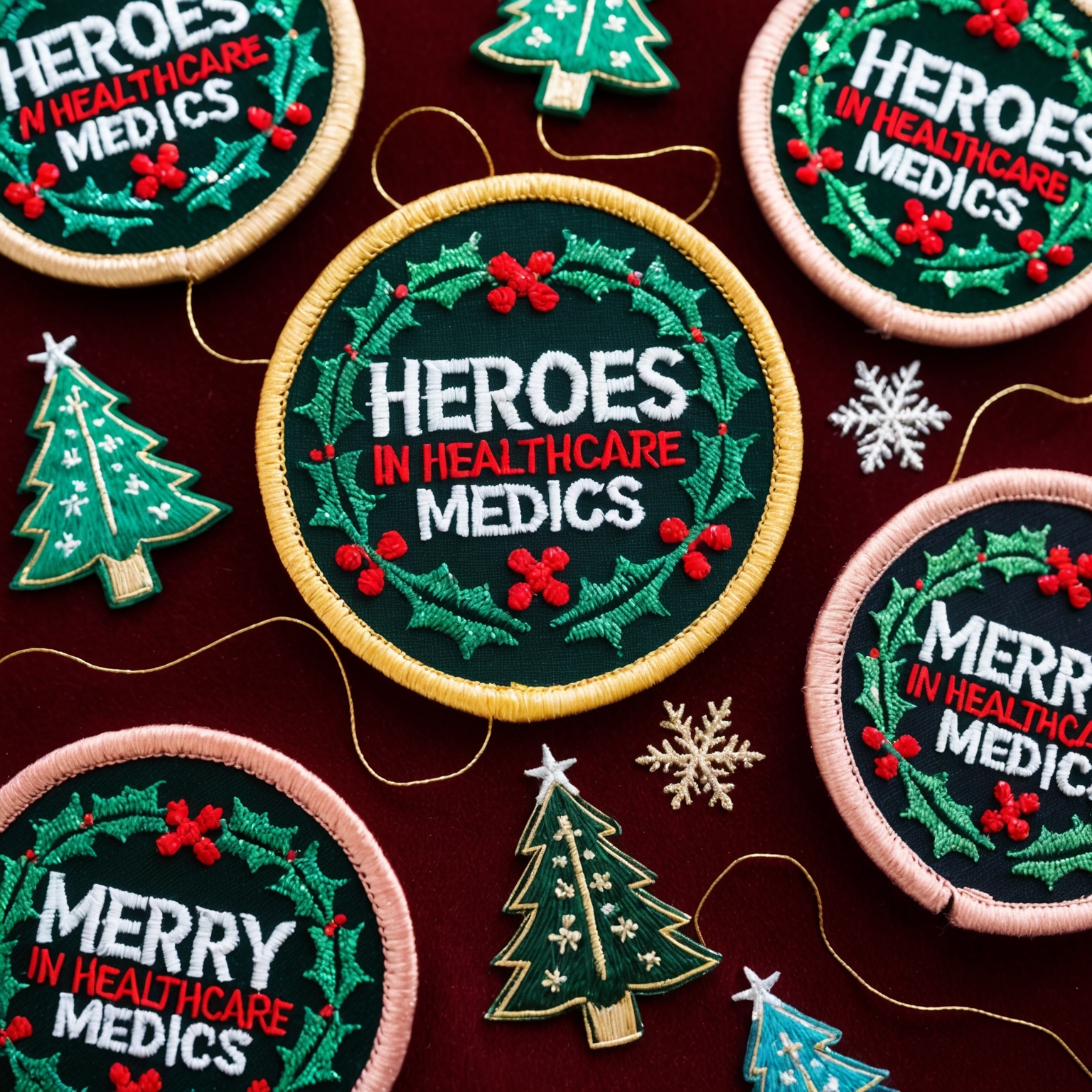Corporate branding is more than just logos, slogans, and marketing campaigns; it’s about creating a cohesive and recognizable identity that resonates with employees, clients, and the broader market. One often overlooked but highly effective tool for enhancing corporate identity is the use of corporate patches. These custom-designed patches can serve a variety of purposes, from employee uniforms to promotional items, and they play a significant role in reinforcing a company’s brand image and culture.
Corporate patches are not just decorative elements; they carry the weight of a brand’s reputation and values. When designed thoughtfully, they can become powerful symbols of professionalism, unity, and pride within a company. This article delves into the key elements of designing corporate patches, exploring how these small yet impactful pieces can contribute to a strong and consistent corporate identity.
1. The Importance of Corporate Patches in Branding
Why Corporate Patches Matter
Corporate patches are an integral part of a company’s branding strategy. They are used in various ways, including on employee uniforms, promotional merchandise, and corporate gifts. The presence of a well-designed patch can enhance the visibility of a brand, create a sense of unity among employees, and even foster loyalty and pride within the organization.
Patches are also versatile. They can be sewn onto clothing, attached with Velcro, or even affixed to accessories like bags and hats. This versatility allows companies to use patches in different contexts, ensuring that their brand is consistently represented across various platforms and events.
The Role of Corporate Patches in Employee Engagement
For employees, wearing a corporate patch on their uniform or apparel is more than just adhering to a dress code; it’s a symbol of belonging to a larger organization with a shared mission and values. Custom patches can foster a sense of pride and unity among employees, particularly when they are designed to reflect the company’s culture and achievements.
In industries where uniforms are a daily part of the job, such as in hospitality, security, or retail, corporate patches help create a professional and cohesive appearance. They reinforce the company’s brand identity and ensure that employees present a unified image to customers and clients.
Corporate Patches as Promotional Tools
Beyond internal use, corporate patches can also serve as effective promotional tools. Custom patches can be included in corporate gift packages, distributed at trade shows, or used as part of marketing campaigns. These patches, when designed with the company’s branding in mind, can help spread awareness of the brand and create a lasting impression on recipients.
2. Key Elements of Effective Corporate Patch Design
Designing corporate patches requires a careful balance of creativity, branding consistency, and functionality. The following elements are crucial in creating a patch that not only looks good but also effectively communicates the company’s brand.
Incorporating the Company Logo
The company logo is often the most recognizable element of a brand, making it a natural focal point for corporate patches. When incorporating a logo into the patch design, it’s important to ensure that it is clearly visible and accurately represented. Here are some tips for effectively using logos in corporate patches:
- Size and Placement: The logo should be prominently placed on the patch, typically in the center or top area. The size of the logo should be proportionate to the overall size of the patch to ensure it remains legible and visually appealing.
- Color Matching: The colors used in the logo should be consistent with the company’s official brand colors. This consistency helps reinforce the brand identity and ensures that the patch aligns with other branded materials.
- Simplification: If the company logo is complex or detailed, it may need to be simplified for the patch design. This can involve removing intricate details or using a more minimalistic version of the logo to ensure it translates well to the embroidered or printed format.
Choosing the Right Symbols and Imagery
In addition to the logo, corporate patches can include other symbols or imagery that represent the company’s values, industry, or products. The choice of symbols should be carefully considered to ensure they align with the brand’s message and resonate with both employees and customers. Here are some considerations for choosing symbols and imagery:
- Industry-Relevant Icons: Symbols related to the company’s industry can be used to add context and relevance to the patch. For example, a tech company might use icons like a circuit board or a lightbulb, while a construction company could incorporate tools like a hammer or a blueprint.
- Abstract Symbols: Abstract symbols can be used to represent broader concepts like innovation, teamwork, or growth. These symbols can add a layer of meaning to the patch and make it more visually interesting.
- Geometric Shapes: Simple geometric shapes like circles, triangles, or squares can be used to create a modern and clean design. These shapes can be combined with other elements to create a balanced and cohesive patch design.
Selecting the Appropriate Colors
Color plays a significant role in the effectiveness of a corporate patch. The colors chosen should not only be visually appealing but also consistent with the company’s branding. Here are some tips for selecting colors:
- Brand Colors: The primary colors of the patch should match the company’s brand colors. This helps maintain brand consistency and ensures that the patch is immediately recognizable as part of the company’s identity.
- Contrast: High contrast between the colors used in the patch can make the design more visually striking and easier to read. For example, using a dark color for the background and a light color for the text and logo can create a strong contrast that enhances visibility.
- Accent Colors: Accent colors can be used to highlight specific elements of the patch, such as the logo or symbols. These colors should complement the primary brand colors and add visual interest without overwhelming the design.
Deciding on the Shape and Size
The shape and size of a corporate patch can significantly impact its overall design and functionality. Common shapes for corporate patches include circles, rectangles, and shields, but custom shapes can also be created to match the company’s logo or industry.
- Round Patches: Round patches are classic and versatile, offering a balanced design that can accommodate a variety of symbols and text. They are often used for general corporate identity patches.
- Rectangular Patches: Rectangular patches are practical and can accommodate more text, making them ideal for name tags, rank insignia, or patches that include detailed information.
- Shield-Shaped Patches: Shield-shaped patches are popular in industries that emphasize security, protection, or leadership. This shape is often used for patches that represent authority or responsibility within the company.
- Custom Shapes: Custom-shaped patches can add a unique touch to the design and make the patch more memorable. For example, a patch could be shaped like the company’s logo, a product, or a symbol related to the industry.
The size of the patch should be appropriate for its intended use. Larger patches are more visible and can include more detail, while smaller patches are more discreet and can be used for specific roles or achievements.
Incorporating Text and Typography
Text is an essential element of corporate patches, as it provides important information such as the company’s name, the wearer’s role, and any special achievements or slogans. Here are some tips for incorporating text into corporate patches:
- Font Choice: The font used in the patch should be legible and appropriate for the overall design. Consider using a font that matches the company’s branding guidelines, whether it’s a modern sans-serif font or a more traditional serif font.
- Placement: Text should be strategically placed to ensure it is easy to read and does not overwhelm the design. Common placements include along the top or bottom edge of the patch, in the center, or in a banner or ribbon across the patch.
- Content: The text on a corporate patch typically includes the company’s name, the specific role or department, and any additional information such as the year or a company slogan.
- Emphasis: Important text, such as the company’s name or a key slogan, can be emphasized through the use of bold, larger font sizes, or contrasting colors.
Selecting Materials and Construction Methods
The material and construction of a corporate patch are critical for ensuring durability, comfort, and functionality. Here are some common materials and construction methods used in corporate patches:
- Embroidered Patches: Embroidered patches are created by stitching thread onto a fabric backing, resulting in a textured, raised design. They are durable and have a classic look, making them a popular choice for corporate patches.
- Woven Patches: Woven patches use thinner threads that are woven together to create a flat, smooth surface. This allows for more intricate designs and finer details, making them ideal for patches with small text or complex symbols.
- PVC Patches: PVC (polyvinyl chloride) patches are made from soft, flexible plastic and are highly durable and weather-resistant. These patches are ideal for outdoor or high-impact environments, making them suitable for industries like construction or security.
- Heat-Transfer Patches: Heat-transfer patches are created by printing a design onto a fabric backing and then applying heat to bond the design to the fabric. These patches offer a smooth finish and can include photographic-quality images, but they may not be as durable as embroidered or PVC patches.
- Velcro Backing: Many corporate patches are designed with Velcro backing, allowing them to be easily attached and removed from uniforms. This is particularly useful for patches that need to be swapped out frequently, such as rank insignia or special achievement badges.
3. Integrative Design Strategies for Corporate Patches
Creating a successful corporate patch requires more than just choosing the right symbols, colors, and materials. It involves integrating these elements into a cohesive design that effectively communicates the company’s brand and values. Here are some integrative design strategies to consider:
Balancing Brand Identity with Functionality
While it’s important for a corporate patch to be visually appealing, functionality should never be compromised. The patch should be durable enough to withstand the demands of the job, comfortable to wear, and easy to clean. Consider the conditions in which the patch will be worn—whether it’s exposed to the elements, subjected to frequent washing, or required to be highly visible in low-light situations. Balancing these functional requirements with the design’s aesthetics is key to creating a successful patch.
Reflecting Corporate Values
The design of a corporate patch should reflect the company’s values and mission. This can be achieved through the careful selection of symbols, colors, and text. For example, a company that prioritizes innovation might include symbols such as a lightbulb or gears, while a company focused on sustainability might use green tones and nature-related imagery. The patch should serve as a visual representation of what the company stands for.
Encouraging Employee Input
Involving employees in the design process can lead to a more meaningful and successful patch. Consider gathering feedback or holding a design contest within the company to see what ideas resonate with employees. This not only helps create a patch that employees are proud to wear but also fosters a sense of ownership and involvement in the company’s branding efforts.
Layering Elements for Depth
Layering design elements can add depth and visual interest to a corporate patch. For example, the main symbol (such as the company logo) could be placed in the foreground, with a background element (such as a geometric pattern or abstract shape) adding context and meaning. Layering can also be achieved through the use of different textures, such as combining embroidered elements with PVC details.
Using Borders and Edges to Frame the Design
Borders and edges can be used to frame the design and add structure to the patch. For example, a bold border can help define the shape of the patch and draw attention to the central symbols and text. Edges can also be customized with stitching patterns, such as merrowed edges, which provide a clean, finished look, or laser-cut edges for more intricate shapes.
Incorporating Personalization
Personalization can make a corporate patch even more meaningful to the wearer. Consider including elements such as the employee’s name, department, or years of service. This can be done through embroidery, engraving, or heat-transfer methods. Personalized patches are especially valuable for recognizing individual achievements or milestones within the company.
4. Best Practices for Creating and Distributing Corporate Patches
Once the design process is complete, the next steps involve creating the patches and distributing them to employees, clients, or partners. Here are some best practices for ensuring that the patches are well-received and effectively serve their purpose:
Partnering with a Reputable Manufacturer
Working with a reputable patch manufacturer is essential for ensuring high-quality results. Look for a manufacturer with experience in creating corporate patches and a track record of delivering durable, well-crafted products. The manufacturer should offer a range of materials, finishes, and customization options to meet your specific needs.
Conducting a Pilot Run
Before ordering a large batch of patches, consider conducting a pilot run to test the design and materials. This allows you to evaluate the patch’s appearance, durability, and comfort before committing to a full order. A pilot run can also help identify any design adjustments that may be needed.
Ensuring Proper Placement and Attachment
Once the patches are created, it’s important to ensure they are properly attached to uniforms or other garments. Provide clear guidelines on where the patches should be placed, such as on the shoulder, chest, or sleeve. If the patches have Velcro backing, make sure the uniforms are equipped with the corresponding Velcro loop. For sewn-on patches, ensure that they are securely stitched to prevent them from coming loose during use.
Recognizing Achievements and Milestones
Corporate patches are often used to recognize achievements and milestones within the company. Consider holding a special ceremony or event to distribute these patches, allowing the recipients to be publicly recognized for their accomplishments. This not only enhances the significance of the patch but also motivates other employees to strive for similar achievements.
Encouraging Patch Traditions
Patches can become an important part of a company’s culture and traditions. Encourage employees to take pride in their patches and share the stories behind them. This could involve creating a “patch wall” in the office where patches from different departments or special events are displayed, or organizing patch exchange events where employees can trade patches with their colleagues.
5. Case Studies: Successful Use of Corporate Patches
To illustrate the impact of corporate patches, here are a few case studies from companies that have successfully used patches to enhance their branding and employee engagement:
Case Study 1: Tech Company Recognizes Innovation with Custom Patches
A leading technology company wanted to recognize the innovative contributions of its engineering team. The company designed custom patches featuring a circuit board pattern, the company’s logo, and the words “Innovator” embroidered in bold letters. The patches were awarded during an internal awards ceremony, where the engineering team was honored for their groundbreaking work on a new product line. The patches became a source of pride for the engineers, who wore them on their jackets and backpacks, symbolizing their role in the company’s success.
Case Study 2: Hospitality Chain Creates Unified Employee Identity with Patches
A global hospitality chain introduced custom patches as part of a new uniform initiative aimed at creating a cohesive and professional appearance across all its locations. The patches featured the company’s logo, the name of the hotel, and the employee’s role, such as “Concierge” or “Housekeeping.” The patches were sewn onto the uniforms of all employees, from front desk staff to housekeeping, ensuring that every team member presented a unified and consistent brand image to guests. The patches also helped foster a sense of pride and belonging among employees, reinforcing their connection to the company’s brand and mission.
Case Study 3: Manufacturing Firm Honors Service Milestones with Commemorative Patches
A manufacturing firm wanted to celebrate long-term employee loyalty and dedication. The company designed a series of custom patches to commemorate service milestones, such as 5, 10, and 20 years of service. Each patch featured the company’s logo, the number of years, and a symbol representing the employee’s department, such as gears for the engineering team or a wrench for the maintenance crew. The patches were awarded during the company’s annual employee recognition event, where recipients were honored for their contributions to the company’s success. The patches became cherished keepsakes, proudly worn by employees as a symbol of their commitment and achievements.
The Power of Corporate Patches in Branding and Employee Engagement
Corporate patches are more than just decorative elements; they are powerful tools for reinforcing brand identity, fostering employee engagement, and recognizing achievements within a company. By carefully designing custom patches that reflect the company’s values, mission, and brand, organizations can create meaningful symbols that resonate with both employees and clients.
As you consider incorporating corporate patches into your branding strategy, remember that these patches are not just accessories—they are representations of your company’s commitment to excellence, professionalism, and unity. With thoughtful design and careful distribution, your corporate patches will become cherished symbols of pride and accomplishment, contributing to a stronger and more cohesive corporate identity.
If you are interested in purchasing high-quality custom patches, feel free to call us at 1-866-903-4903 or fill out one of our FREE quotes here.




